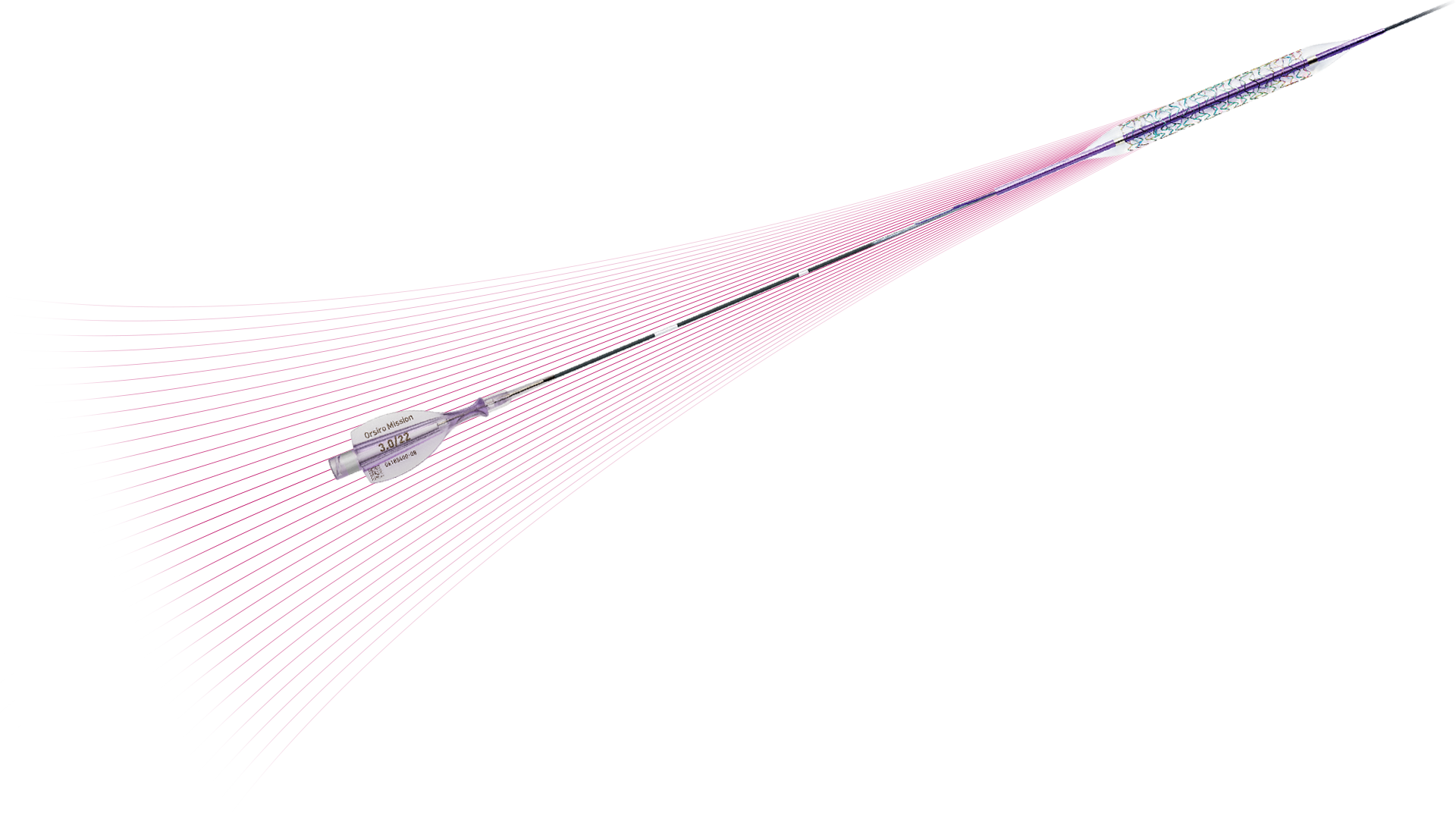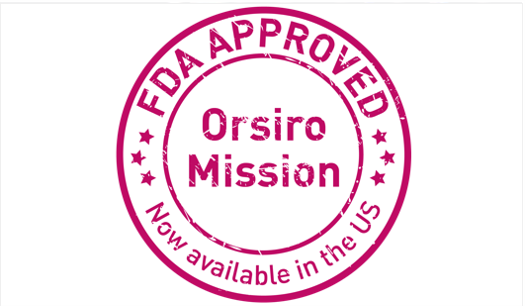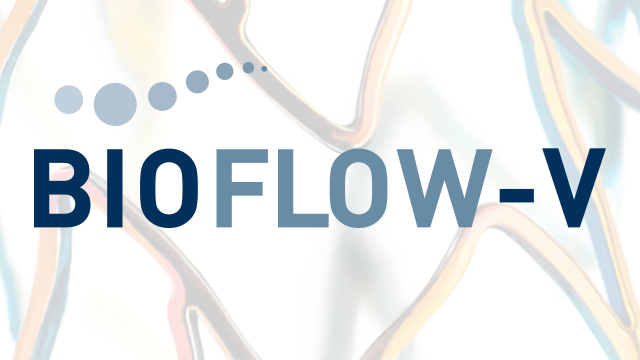1. In comparison to Xience Sierra, Resolute Onyx and Synergy for bench tests on pushability, trackability and crossability, BIOTRONIK data on file 2. As characterized with respect to strut thickness in Bangalore et al. Meta-analysis; 3. Based on investigator’s interpretation of BIOFLOW-V primary endpoint results; 4. BIOTRONIK data on file, status January 2020.
Orsiro, and Orsiro Mission are trademarks or registered trademarks of the BIOTRONIK Group of Companies.
Brief Summary

Indications:
Orsiro and Orsiro Mission are indicated for improving coronary luminal diameter in patients, including those with diabetes mellitus, with symptomatic heart disease, stable angina, unstable angina, non-ST elevation myocardial infarction or documented silent ischemia due to atherosclerotic lesions in the native coronary arteries with a reference vessel diameter of 2.25 mm to 4.0 mm and a lesion length of ≤ 36 mm.
Contraindications:
Orsiro and Orsiro Mission are contraindicated for use in patients with a known hypersensitivity or allergy to the stent and/or stent coating materials such as amorphous silicon carbide, PLLA polymer, L-605 cobalt chromium alloy (including the major elements cobalt, chromium, tungsten and nickel), sirolimus or its derivatives.
Coronary artery stenting is contraindicated for use in the following patients:
- Patients who have contraindications for antiplatelet and/or anticoagulation therapy.
- Patients who are judged to have a lesion that would be likely to prevent complete inflation of an angioplasty balloon or proper placement of the stent or delivery device.
Warnings
- For single use only. Do not re-sterilize and/or re-use.
- Do not use the stent system if the outer or inner package is damaged or opened, or if any information provided is obscured or damaged.
- Do not use the device after the ‘Use by’ date
- Do not attempt to remove or readjust the stent on the delivery system as it may damage the stent, polymer system and/or lead to stent embolization.
- Do not expose and/or suspend the stent within any liquid solution in the sterile field prior to preparation and insertion as the drug carrier coating may be susceptible to damage or premature drug elution.
- Administration of appropriate anticoagulant, antiplatelet and vasodilation therapy is critical to successful stent implantation
- Manipulate the stent system under angiographic guidance when it is in the body.
- Use stents with a similar composition when multiple stents are required to treat the lesion as the risk of corrosion increases when stents of dissimilar metals contact one another.
- Do not exceed the original diameter of the vessel proximal and distal to the lesion when inflating the balloon to reduce the potential for vessel damage.
- Balloon pressure should not exceed the Rated Burst Pressure (RBP). Use of a pressure-monitoring device is mandatory to prevent over-pressurization.
- Use only an appropriate balloon inflation medium. Never use air or any gaseous medium to inflate the balloon.
- Subsequent restenosis may require repeat dilation of the arterial segment containing the stent. The long-term outcomes following repeat dilation of endothelialized stents are unknown.
Precautions
General:
- This device should only be used at medical facilities by physicians who are adequately trained and experienced in performing vascular interventions (including cases of life-threatening complications).
- If the stent system was removed prior to expansion, do not re-insert as the stent and/or the delivery system may have been damaged during the initial attempt to cross the lesion or during withdrawal.
- This device carries an associated risk of thrombosis, vascular complications and/or bleeding events. Therefore, careful selection of patients is critical. The long-term effects of DES and the risks associated with these implants are unknown. The limited availability of long-term clinical data should be considered before making a risk/benefit assessment for the patient prior to implantation.
- Stent thrombosis is a low-frequency event that is frequently associated with myocardial infarction (MI) or death. Data from the BIOFLOW clinical trials have been prospectively evaluated and adjudicated using the definition developed by the Academic Research Consortium (ARC). The rate of stent thrombosis for Orsiro was low in the BIOFLOW clinical trials and did not differ significantly from expectations for a current generation DES.
- The patient’s exposure to the drug and polymer system is directly related to the number of stents and the stent length implanted.
- Potential interactions of Orsiro and Orsiro Mission with other DES have not been evaluated and should be avoided whenever possible.
Pre- and Post-procedure Antiplatelet Therapy Recommendations: Antiplatelet/anticoagulation medication should be used in combination with Orsiro and Orsiro Mission. Physicians should consider the information from the current drug-eluting stent literature and the current ACC/AHA guideline recommendations on PCI concerning the selection, dosage, duration and combination of different antithrombotic drugs. Specific needs and the risk profile of individual patients may influence the antiplatelet/anticoagulation regime to be used. The optimal duration of antiplatelet therapy, specifically P2Y12 inhibitor therapy, is unknown and DES thrombosis may still occur despite continued therapy.
Oral Antiplatelet Therapy: Dual antiplatelet therapy (DAPT) using a combination treatment of aspirin with a P2Y12 platelet inhibitor after percutaneous coronary intervention (PCI) reduces the risk of stent thrombosis and ischemic cardiac events but increases the risk of bleeding complications. The optimal duration of DAPT (specifically, a P2Y12 platelet inhibitor in addition to aspirin) following DES implantation is unknown, and DES thrombosis may still occur despite continued therapy. It is very important that the patient is compliant with the post-procedural antiplatelet recommendations. Per 2016 ACC/AHA guidelines, a daily aspirin dose of 81 mg is recommended indefinitely after PCI. A P2Y12 platelet inhibitor should be given daily for at least 6 months in stable ischemic heart disease patients and for at least 12 months in patients with acute coronary syndrome (ACS). Consistent with the DAPT Study and the 2016 ACC/AHA guidelines, longer duration of DAPT may be considered in patients at higher ischemic risk with lower bleeding risk. In patients at higher risk of bleeding, DAPT discontinuation may be reasonable after 3 months in stable patients or 6 months in ACS patients. Decisions about the duration of DAPT are best made on an individual basis and should integrate clinical judgment, assessment of the benefit/risk ratio, and patient preference. Premature discontinuation or interruption of prescribed antiplatelet medication could result in a higher risk of stent thrombosis, MI or death.
Refer to the Orsiro and Orsiro Mission Instructions for Use (IFU) for additional precautions related to handling and stent Placement. Refer to the “MRI Safety Information” section of the Orsiro and Orsiro Mission IFUs for the stent’s MRI compatibility information.
The safety and effectiveness of Orsiro and Orsiro Mission have not yet been established in patients with the following:
- In-stent restenosis.
- 3 vessel coronary disease.
- An unresolved thrombus at the lesion site.
- Coronary artery reference vessel diameters < 2.25 mm or > 4.0 mm.
- Lesion length > 36 mm.
- Chronic total occlusion (CTO).
- Lesions located in a saphenous vein graft, in the left main coronary artery, ostial lesions, or bifurcation lesions.
- Target vessel/lesion is excessively tortuous / angulated or is severely calcified that would prevent complete inflation of an angioplasty balloon.
- Recent acute MI where there is evidence of thrombus or poor flow.
- Brachytherapy treatment of the target lesion.
- Pregnant or lactating women or men intending to father children
- Pediatric patients
Potential Adverse Events
Cardiac events: MI or ischemia, abrupt closure of coronary artery, restenosis of treated artery (greater than 50% obstruction), cardiogenic shock, angina, tamponade, perforation or dissection of coronary artery or aorta, cardiac perforation, emergency cardiac surgery, pericardial effusion and aneurysm formation. Arrhythmic events: ventricular tachycardia, ventricular fibrillation, atrial fibrillation and bradycardia. Stent system events: failure to deliver stent to intended site, stent dislodgement from the delivery system, stent misplacement, stent deformation, stent embolization, stent thrombosis or occlusion, stent fracture, stent migration, inadequate apposition or compression of stent/s, inflation difficulties, rupture or pinhole of the delivery system balloon, deflation difficulties, withdrawal difficulties and embolization of catheter material. Respiratory events: acute pulmonary edema, congestive heart failure and respiratory insufficiency or failure. Vascular events: access site hematoma, hypotension/hypertension, pseudoaneurysm, arteriovenous fistula formation, retroperitoneal hematoma, vessel dissection or perforation, restenosis, thrombosis or occlusion, vasospasm, peripheral ischemia, dissection and distal embolization (air, tissue debris and thrombus). Neurologic events: permanent (stroke) or reversible (TIA) neurologic event, femoral nerve injury and peripheral nerve injury. Bleeding events: access site bleeding or hemorrhage, hemorrhage requiring transfusion or other treatment. Allergic reactions to contrast media, antiplatelets, anticoagulants, amorphous silicon carbide, L-605 cobalt chromium alloy, PLLA polymer matrix, sirolimus or sirolimus derivatives. Death. Infection and sepsis. Furthermore, all procedure-related adverse events as described in the national and international guidelines of the respective medical associations apply. Potential adverse events related to the oral administration of sirolimus include, but are not limited to, abnormal liver function tests, anemia, arthralgia, diarrhea, hypercholesterolemia, hypersensitivity (including anaphylactic/anaphylactoid type reactions), hypertriglyceridemia, hypokalemia, infections, interstitial lung disease, thrombocytopenia, leukopenia, lymphoma and other malignancies.
Please reference the appropriate product Instructions for Use for more information regarding indications, warnings, precautions, and potential adverse events.





